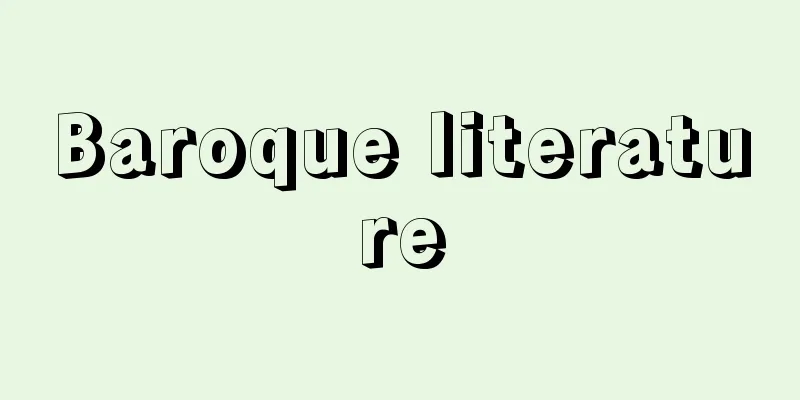Baroque literature

|
The concept of Baroque began to be used in the field of literature when F. Strich, aiming to restore the power of 17th-century German literature, repurposed the concept defined by Wölfflin in art history (The Style of 17th-century Lyric Poetry, 1916). As a result, the literary art of about 120 years from German humanism to the Enlightenment, which had not been considered from a comprehensive perspective until then, came to be called "Baroque", with its indicators of opposition and decorativeness. Since then, there has been endless debate about whether works of this era have a unified characteristic, but the common idea that polarity and internal tension form the basic form of Baroque thinking, world experience, life sentiment, artistic motivation, etc. Schematically, the conflicts and tensions are universality and particularity, the world in general and the nation or country, citizen status consciousness and court culture, citizen learning and aristocratic lineage, the joys of this world versus the fear of death and the desire for the afterlife, the formal beauty of pagan classical antiquity and the profoundness of Christian content, the desire for exhibitionism and transience of the court world, the rise and fall, the observance of norms and rules and the tendency toward fantasy and fantasy. Because this view of style history was first established in Germany, until World War II, there was a strong tendency to say that "Baroque literature" was a uniquely German phenomenon. On the other hand, there were those who took up this conflict diagram and universally understood "Baroque" as a phenomenon of abundance and ripeness that followed the classicism of harmony and unity (Dors, Focillon, etc.), but both were rejected by the research and criticism, especially by E. R. Curtius (European Literature and the Latin Middle Ages, 1948). Therefore, today, the term Baroque literature is used as a concept of the period in Western European literature, mainly in the 17th century, when a conflict arose between the imitation and inheritance of classical literary forms and the desire to create modern literature, and when a "national literature" unique to each language and culture was established. In terms of expression, it is an artistic style that is based on verse and uses a unique allegory called "fantasia," while at the same time conveying the atmosphere of the Counter-Reformation era. In addition to the modern poetic form of the sonnet, various classical poetic forms were established under canonical poetics, and Stoic Christian tragedy, based on the 12-syllable Alexandrine verse, was one of the most important genres. Furthermore, this period was also the period when the prose picaresque (villain) novel and court romance novel, which were newly born in the 16th century, rapidly developed and grew in both quality and quantity. The "controversy between the old and the new" that occurred in France at the end of the 17th century is considered to be a truly epoch-making event that marked the end of the Baroque era. Baroque literature, which has the above characteristics, first flourished in Spain, where it is represented by Góngora, Calderón, Gracian, and Lope de Vega. In France, poets such as d'Aubigné, du Bartas, and Spond, as well as the tale writer Mademoiselle Scuderi and the dramatist Corneille, emerged alongside classical literature. In Italy, there were philosophers Bruno and Campanella, and the poet Marino, who influenced the whole of Europe. In England, the term Baroque is not usually used, but metaphysical poets such as Donne and Milton are examples. In Germany, the momentum for Baroque literature finally began in the 17th century, and it produced such poets as Opitz, the dramatist Gleufius, and novelists Grimmelshausen and Hofmann-Swaldau. [Kuchida Osamu] [Reference] |Source: Shogakukan Encyclopedia Nipponica About Encyclopedia Nipponica Information | Legend |
|
文学の領域でバロックという概念が用いられるようになったのは、F・シュトリヒがドイツ17世紀文学の復権を目ざして、美術史においてウェルフリンが規定した概念を転用したことに始まる(『17世紀抒情(じょじょう)詩の様式』1916)。これによって、それまで総合的な観点からはとらえられていなかったドイツの人文主義から啓蒙(けいもう)時代に至る約120年の文芸が、対立性と装飾性を指標とした「バロック」の名称でよばれることになった。以後この時代の作品が統一的な特徴をもっているかどうかについては論議が絶えないが、対極性と内的な緊張関係が、バロック時代の考え方、世界経験、生活感情、芸術意欲などの基本形態を形成しているという通念は成立している。対立と緊張は、図式的には、普遍性と個別性、世界全般と民族ないし国、市民の身分意識と宮廷文化、市民の学識対貴族の血統、現世の歓(よろこ)びに対する死の恐れと彼岸(ひがん)願望、異教的な古典古代の形式美とキリスト教的な内容の重厚さ、宮廷世界の顕示欲とはかなさ、移ろいやすさ、上昇と下降、規範規律の遵守と幻想空想への傾き、といった形をとる。この様式史観は最初ドイツに成立したため、第二次世界大戦中まで、「バロック文学」とは特殊ドイツの現象と説く傾向が強かった。他方、こうした対立図式を取り上げて、「バロック」を調和と統一の古典主義の後に続く豊饒(ほうじょう)と爛熟(らんじゅく)の現象として普遍的にとらえるむきもあったが(ドールス、フォシヨンら)、とくにE・R・クルチウス(『ヨーロッパ文学とラテン中世』1948)の研究批判によっていずれも否定された。それゆえ今日では、バロック文学の名称は、おおむね17世紀を中心とした西欧の文学において、古典古代の文学形式の模倣・継承と近代的な文学形成意欲との葛藤(かっとう)が生じ、また、それぞれの言語文化に特有な「国民文学」が成立してくる時期の時代概念として用いられる。表現法においては、韻文が基本であり、「奇想」とよばれる独特なアレゴリーを用い、同時に反宗教改革時代の雰囲気を伝える芸術様式である。近代詩形のソネットのほか多様な古典詩形が規範詩学のもとに確定し、また12音綴(てつ)のアレクサンドリーナ(アレクサンドラン)詩行を基本としたストア的キリスト教的悲劇がもっとも重要なジャンルの一つであった。さらに、新たに16世紀に誕生した散文によるピカレスク(悪者)小説と宮廷恋愛小説が質量ともに急速に発展成長した時期もこの時代にあたる。17世紀末にフランスでおきた「新旧論争」は、こうしたバロック時代の終幕を示すまさに画期的なできごとであったと考えられる。 以上の特徴をもつバロック文学は、スペインにおいてもっとも早く開花し、ゴンゴラ、カルデロン、グラシアン、ロペ・デ・ベガに代表される。フランスでは古典主義文学に並ぶ形で現れた、ドービニェ、デュ・バルタス、スポンドらの詩人、そして奇譚(きたん)作家スキュデリ嬢、劇詩人コルネイユらがあげられる。イタリアでは哲学者ブルーノ、カンパネッラ、そしてヨーロッパ全土に影響を与えた詩人マリーノがいる。イギリスでは通常、バロックの名称は用いないが、ダンを代表とする形而上(けいじじょう)詩人たちやミルトンがこれにあたる。ドイツでは17世紀に入りようやくバロック文学の機運が生じ、詩学のオーピッツ、劇詩人グリューフィウス、小説のグリンメルスハウゼン、ホフマンスワルダウらが輩出した。 [轡田 收] [参照項目] |出典 小学館 日本大百科全書(ニッポニカ)日本大百科全書(ニッポニカ)について 情報 | 凡例 |
Recommend
Grateloupia divaricata (English spelling)
…[Mitsuo Chihara]. . . *Some of the terminology t...
Leyden jar - Leyden jar (English spelling)
A capacitor made by covering the inside and outsid...
Sumida River Memories - Memories of the Sumida River
A Kabuki play. Sewamono (domestic story). Four ac...
Hystera
... Representative malignant tumors include cervi...
Gatling - Gatling
…There is no record of a five-story pagoda ever c...
Electric polarization
Polarization caused in a dielectric material by an...
Dizziness, Vertigo
How dizziness occurs In order to maintain balance...
Ferdinand III
1608‐57 Holy Roman Emperor. Reigned 1637-57. Son o...
acetylsalicylic acid
For example, the methyl ester methyl salicylate (...
International Military Education and Training Program
The military aid currently being implemented by t...
Carr, L.
...Since the 1960s, as the social lives and consc...
Tijānī (English spelling) Tijani
…An Islamic mystical sect (tariqa) founded by T...
Kusado Sengen
The remains of a medieval city are located on an i...
Battle of the Catalaunian Empire - Battle of the Catalaunian Empire
In 451, the combined Roman and Visigothic armies o...
Gol'd (English) Gold
...Group B: (5) Udehe, (6) Orochi. Group C: (7) N...









